 |
||
|
||
| ||
Optical recording devices (CD-RW)The February turned out to be quiet; it concerns both new announces and changes in the sales and delivery levels. The distributors would probably be able to sell more but stocks of their vendors were often empty. The latter were afraid of the glut on the recorder market, like it took place last year. I'm glad a lot of vendors refused to jump from one speed level to another; and the most of them are producing 16x models which are still in a great demand. The storage devices market follows its own rules as well. 24x CD-R media have almost completely replaced 12x models, though the latter are in demand thanks to its low price. 32x CD-R discs are also coming soon. The most of vendors are waiting for CeBIT 2002 to pour out new stuff. Modern technologies and their development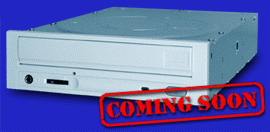 On February 1 Mitsumi announced a near release of its CR-480ATE drive. The drive works at 32/12/40 speeds (Zone-CLV technology), has a 16 MBytes buffer and ExacLink buffer protection technology of Oak Technology. Both new drives differ from the Mitsumi CR-4809TE, which was a hit at the beginning of the year, only in speeds - the CR-4809TE has it 24 for CD-R. LiteOn said they were soon going to release new LTR-40125S CD-RW drive with 40/12/48 speeds, a 2 MBytes buffer, Smart-Burn and Smart-X technologies and Mt. Rainier format support. For recording at such high speeds the drive uses the Zone-CLV technology when a disc is recorded at 40x in 4 steps: 20x -> 24x -> 32x -> 40x. TEAC released its 40x CD-W540E CD-RW drive (as you remember, its 40x CD-ROM was named CD-540E). Later, however, we found out that the correct name of the drive was CD-RW540EKB. The drive works at 40/12/40 speed, has a 8 MBytes buffer and will support Mt. Rainier format. 40x speed will be reached due to the Zone-CLV technology. The most of other characteristics will be similar to the CD-W524EKB model. The access time in the read mode is 72 ms. The TEAC CD-W540EKB is expected in the middle of March at approximately $145. 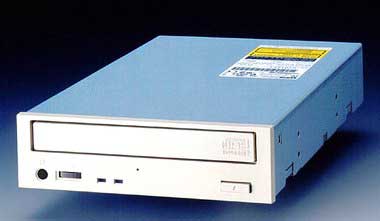 Iomega stopped production of Iomega Jaz drives. As you know, the production started yet in early 90s and they could record up to 1 GBytes or 2 GBytes of data on "superdiskettes". Now Iomega focuses on more profitable Zip models and external CD-RW drives of the Predator line.  SpectraDisc, which is mainly a research company, developed a special coating for DVD discs which allows removing data on it after its first playback. A laser reads and deletes data simultaneously, reacting with a transparent polymer which contains a photosensitive chemical called azobenzene. I think it makes no sense to tell you where this technology is going to be applied. However, this investigation creates one problem - a problem of environmental protection from such discs. Although SpectraDisc states that they can be recycled, watchdogs are on the alert and demand that factories for processing of such discs are obligatory built. Philips Semiconductor and Mitsumi concluded an agreement on joint development, production and promotion of analog and digital-analog chips. Philips and Mitsumi will start cross sales of the products available. Apart from licensing their intellectual property the companies will start selling their jointly developed products via their own channels. Yamaha developed a technology which allows recording on CD-R/RW discs special symbols and pictures so that it can be easier for users to identify media. The detailed information will be available at CeBIT 2002, and now the company just showed how this technology can be used. In all its CD-R/RW drives Yamaha uses the CAV technology. The angular velocity remains constant, it's only a laser's speed that changes. By strengthening the control over a laser's position and a disc rotational speed it's possible draw on the unused space.  OPTWARE reports it has developed a unique technology of data recording on optical discs based on holographic recording and reading. According to the company, it's possible to record up to 1 Tbyte of data on one 120mm optical disc at the data rate up to 1 GBytes/s. The back compatibility with today's CD/DVD technologies is also possible. 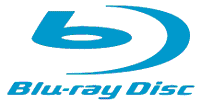 On February 19 nine companies - leaders in development of new generations of DVD technologies: Hitachi, LG Electronics, Matsushita Electric, Pioneer Corporation, Royal Philips Electronics, Samsung Electronics, Sharp Corporation, Sony and Thomson Multimedia announced a new format of recording of optical discs for video recording. The new format is named "Blu-ray Disc" because of the blue-violet laser wavelength. The new discs will also be 12 cm in diameter and can store up to 27 GB per one side with a laser of 405 nm wavelength. The companies plan to begin licensing the new format as soon as specifications are completed. Licensing is expected to start around spring 2002. "By employing a short wavelength blue violet laser, the Blu-ray Disc successfully minimizes its beam spot size by making the numerical aperture (NA) on a field lens that converges the laser 0.85. In addition, by using a disc structure with a 0.1mm optical transmittance protection layer, the Blu-ray Disc diminishes aberration caused by disc tilt. This also allows for disc better readout and an increased recording density. The Blu-ray Disc's tracking pitch is reduced to 0.32um, almost half of that of a regular DVD, achieving up to 27 GBytes high-density recording on a single sided disc." Because the Blu-ray Disc utilizes global standard "MPEG-2 Transport Stream" compression technology a wide range of content can be recorded - up to 2 hours of HDTV, over 13 hours of standard TV signal (3.8 Mbit/s). The Blu-ray discs will have cartridges to protect the optical disc's recording and playback phase from dust and fingerprints. The companies listed above are also aiming to further enhance the appeal of the new format through developing a larger capacity, such as over 30 GBytes on a single sided single layer disc and over 50 GBytes on a single sided double layer disc. Main Specifications:
Plextor announced its first combo drive - PlexCombo 20/10/40-12A. The PlexCombo 20/10/40-12A has the E-IDE (ATAPI) interface, a 2 MBytes buffer and works at 20/10/40+12 speeds. The drive supports BURN-Proof, PoweRec-II and VariRec technologies. At the expense of a black tray and additional absorption of side radiation of the laser the company managed to reduce the number of C1 errors during recording. The Retail version of the PlexCombo 20/10/40-12A coming with CD-R and CD-RW discs, E-IDE and audio cables, software (Plextools, Nero + InCD, PowerDVD) and a user manual in 16 languages is expected in April 2002 at approximately 229 euros. Sony unveiled two digital cameras which use 8cm CD-R and CD-RW discs for storing photos - Mavica MVC-CD250 and MVC-CD400. 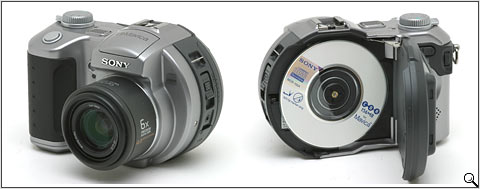 The CD Mavica cameras have special functions of photo compression and recording onto CD-R and CD-RW media. These models come with 6 CD-R and 1 CD-RW discs. The CD Mavica cameras will appear on the shelves in May at $600 for the MVC-CD250 and $900 for MVC-CD400. Sony has also declared that it starts mass production of semiconductor SLD253VL laser diode with a wavelength of 784 nm and radiated power of 250 mW meant for CD-RW drives with 48x and higher speed of CD-R recording. The SLD253VL incorporated the MOCVD technology (Metal Organic Chemical Vapor Deposition). The COD technology (Catastrophic Optical Damage) controls its emission and maintains it within the range of 250 mW. Besides, the company began production of the semiconductor laser diode SLD1233VL with a wavelength of 650 nm and radiated power of 100 mW meant for DVD drivers. This model will start shipping in May 2002; the diodes will be available at $7.7 for the SLD253VL and $15.3 for the SLD1233VL. Thomson Multimedia announced that it arrived at the agreement on purchasing the North-American department of Matsushita Electric dealing in production of DVD and CD drives under the Panasonic trade mark. The deal is estimated 300 million euros ($261.5 million), all financial and juridical issues are to be solved until the end of March and after that Thomson plans to gradually integrate Panasonic Disc Services Corporation into its North-American audio/video subdivision during 12 months. The analysts say that Thomson will also be able to improve relationships with Universal Studios and Paramount by taking this step. For Matsushita this deal is one of the stages in restructuring aimed at income return. It is expected that the fiscal year ending by March 31 will be unprofitable ($3.3 billion loss). As a result, Thomson gets 5 plants in USA, Mexico and Europe, as well as 1600 Matsushita's employees. The Japanese company leaves only one factory in California which will also be brought to a stop, sold or given the minimal load. Verbatim and Mitsubishi Chemicals declared that new 4.7 GB (or rather 4.38 GBytes) DVD+R discs became available (Verbatim's line is still named as DataLifePlus) for DVD+RW drives. Now the companies offer for DVD+RW drives both types of media - ReWriteable and Write-once. The new DVD+R discs can be recorded at 2.4x (which is equivalent to 3.32 MBytes/s, or 22x for CD-R). To provide support of such speed the developers used the Metal Azo coating technology from Mitsubishi Chemical Corporation (MCC). The Verbatim DataLifePlus DVD+R are expected to appear in March at $9.99 per a 4.7 GBytes single sided disc. They will appear on the Japanese market also in March.  Sony (again!) announced that it was going to start selling 2 new CD-RW drives - external CRX1750MU with USB 2.0 interface and internal CRX185A1 with ATAPI interface. 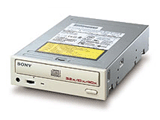 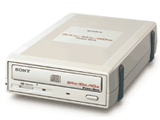 The CRX1750MU supports 24/10/40 speeds, is equipped with a MemoryStick slot and drivers for Windows 98 SE/ME/2000/XP and Mac OS 9.0.4/9.1/9.2.1 (under the Mac OS it supports only USB 1.1). It measures 164 x 246.6 x 53.2 mm and weighs 1.9 kg. The guiding price is 20,000 yens. The internal ATAPI CRX185A1 drive works at 32/10/40 speeds, the access time in the read mode is 150 ms, it operates under Windows 98 SE/ME/2000/XP. The drive's dimensions are 145.8 x 195 x 41.3 mm and the weight is 1 kg. The price is 13,000 yens. Both drives record using the Zone-CLV technology, have a 2 MBytes buffer and support Power-Burn buffer protection technology and CD-Text format. The review is based on materials from the following sites: and from the sites of the following manufacturers:
Write a comment below. No registration needed!
|
Platform · Video · Multimedia · Mobile · Other || About us & Privacy policy · Twitter · Facebook Copyright © Byrds Research & Publishing, Ltd., 1997–2011. All rights reserved. |